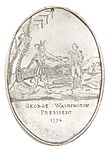Fish Carrier (Ojageght) facts for kids
Fish Carrier was an important Iroquois chief of the Cayuga nation. His name in the Cayuga language, "Ojageght," means "he is carrying a fish by the forehead strap." He played a big role during the American Revolution, supporting the British side. He was involved in major battles like the Battle of Wyoming in 1778 and the Battle of Newtown in 1779.
Fish Carrier and the American Revolution
During the American Revolutionary War, Fish Carrier and the Cayuga people sided with the British. In July 1777, the Cayuga and Seneca nations decided to join the fight against the Americans. Fish Carrier accepted a "war belt" for the Cayuga, showing their commitment. He likely took part in the Siege of Fort Stanwix and the Battle of Oriskany later that summer.
In September 1779, American forces launched the Sullivan Expedition. They destroyed many Cayuga villages. Because of this, the Cayuga people, including Fish Carrier, had to flee. They went to Fort Niagara and then moved to Buffalo Creek the next spring.
Fish Carrier also joined several raids in 1780. One important raid was in August 1780 on the Canajoharie area. This raid was led by Joseph Brant. During this attack, 53 houses were burned, along with barns, a gristmill, a church, and two small forts.
Life After the War
After the war, most Cayuga people, including Fish Carrier, stayed at Buffalo Creek. Some Cayuga moved to the Grand River in Canada. This land was given to the Iroquois by the British Governor, Frederick Haldimand, in 1784.
A group of Cayuga, led by Steel Trap, returned to the Cayuga Lake area. In February 1789, they made a treaty with Governor George Clinton of New York. This treaty gave away most of the Cayuga's traditional land. However, about 64,000 acres at the north end of Cayuga Lake were kept. Even though Fish Carrier was not there, one square mile of land was set aside for him. In June 1790, Fish Carrier met with Governor Clinton at Fort Stanwix and agreed to this 1789 treaty.
Fish Carrier attended important meetings with American officials. He met with Indian Commissioner Timothy Pickering at Tioga Point in November 1790 and at Painted Post in July 1791. He also advised Red Jacket during a meeting in Buffalo in April 1791.
In March 1792, Fish Carrier was part of a group of Seneca and Cayuga leaders who met with George Washington in Philadelphia. Fish Carrier, along with other chiefs like Red Jacket and Cornplanter, received large silver peace medals. These medals were symbols of friendship.
Fish Carrier was one of the chiefs who signed the Treaty of Canandaigua in November 1794. This treaty created lasting peace and friendship between the Iroquois nations and the United States. It also recognized that the Iroquois had control over their own lands.
Fish Carrier worked to reduce tensions between different Native American groups. He helped calm a tense ceremony where knives were drawn between the Senecas and Oneidas. He stood up and shouted, "You are all a parcel of boys; when you have all attained my age, and performed the warlike deeds that I have performed, you may boast what you have done; not till then!" This showed his strong leadership.
His Name
Fish Carrier's name in Cayuga was written in different ways over time. On the Treaty of Canandaigua, it was "Oo-jau-gent-a." Other documents show it as "Ogageghte" or "Ho-ja-ga-ta." The Handbook of American Indians North of Mexico recorded it as "Ojageght."
His Family
Fish Carrier had three children: a daughter and two sons. After he passed away at Buffalo Creek, his family moved to the Six Nations of the Grand River reserve in Canada. In 1850, a researcher visited the reserve and bought a special shell breastplate that had belonged to Fish Carrier from his son, Peter Fish Carrier.



